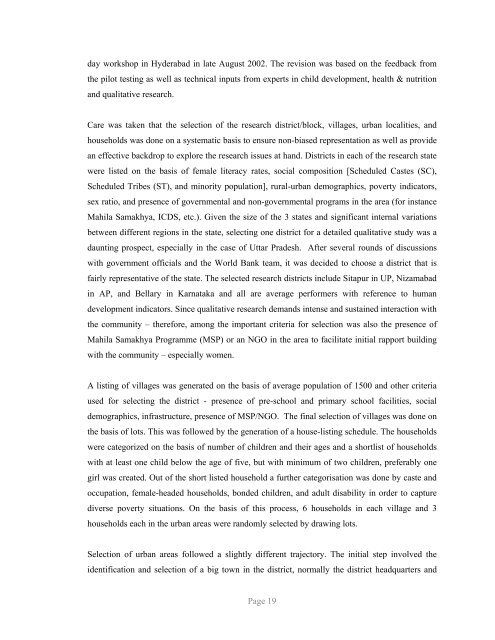Snakes and Ladders - ERU Consultants Pvt. Ltd.
Snakes and Ladders - ERU Consultants Pvt. Ltd.
Snakes and Ladders - ERU Consultants Pvt. Ltd.
You also want an ePaper? Increase the reach of your titles
YUMPU automatically turns print PDFs into web optimized ePapers that Google loves.
day workshop in Hyderabad in late August 2002. The revision was based on the feedback from<br />
the pilot testing as well as technical inputs from experts in child development, health & nutrition<br />
<strong>and</strong> qualitative research.<br />
Care was taken that the selection of the research district/block, villages, urban localities, <strong>and</strong><br />
households was done on a systematic basis to ensure non-biased representation as well as provide<br />
an effective backdrop to explore the research issues at h<strong>and</strong>. Districts in each of the research state<br />
were listed on the basis of female literacy rates, social composition [Scheduled Castes (SC),<br />
Scheduled Tribes (ST), <strong>and</strong> minority population], rural-urban demographics, poverty indicators,<br />
sex ratio, <strong>and</strong> presence of governmental <strong>and</strong> non-governmental programs in the area (for instance<br />
Mahila Samakhya, ICDS, etc.). Given the size of the 3 states <strong>and</strong> significant internal variations<br />
between different regions in the state, selecting one district for a detailed qualitative study was a<br />
daunting prospect, especially in the case of Uttar Pradesh. After several rounds of discussions<br />
with government officials <strong>and</strong> the World Bank team, it was decided to choose a district that is<br />
fairly representative of the state. The selected research districts include Sitapur in UP, Nizamabad<br />
in AP, <strong>and</strong> Bellary in Karnataka <strong>and</strong> all are average performers with reference to human<br />
development indicators. Since qualitative research dem<strong>and</strong>s intense <strong>and</strong> sustained interaction with<br />
the community – therefore, among the important criteria for selection was also the presence of<br />
Mahila Samakhya Programme (MSP) or an NGO in the area to facilitate initial rapport building<br />
with the community – especially women.<br />
A listing of villages was generated on the basis of average population of 1500 <strong>and</strong> other criteria<br />
used for selecting the district - presence of pre-school <strong>and</strong> primary school facilities, social<br />
demographics, infrastructure, presence of MSP/NGO. The final selection of villages was done on<br />
the basis of lots. This was followed by the generation of a house-listing schedule. The households<br />
were categorized on the basis of number of children <strong>and</strong> their ages <strong>and</strong> a shortlist of households<br />
with at least one child below the age of five, but with minimum of two children, preferably one<br />
girl was created. Out of the short listed household a further categorisation was done by caste <strong>and</strong><br />
occupation, female-headed households, bonded children, <strong>and</strong> adult disability in order to capture<br />
diverse poverty situations. On the basis of this process, 6 households in each village <strong>and</strong> 3<br />
households each in the urban areas were r<strong>and</strong>omly selected by drawing lots.<br />
Selection of urban areas followed a slightly different trajectory. The initial step involved the<br />
identification <strong>and</strong> selection of a big town in the district, normally the district headquarters <strong>and</strong><br />
Page 19












